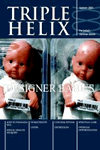The Morning-After Pill
Hilary Cooling, who practises and teaches family practice in Bristol, takes issue with Phil Howard
In his article 'The morning-after pill - how does it really work?' (Triple Helix 2002; Autumn: 8-9) Phil Howard confuses the terms 'post-fertilisation' and 'postimplantation', and uses complex arguments of extrapolation to arrive at his conclusion that the evidence 'strongly suggests that [the morning-after pill] can disrupt implantation'. He gives the impression that he wishes the evidence to support his view, which was recently rejected by the High Court in the UK.
Has Howard taken his arguments to a journal such as the Lancet for robust debate? In the interests of intellectual honesty, how about inviting a response from Horaciao Croxatto, author of 'Emergency contraception pills: how do they work?' (IPPF Medical Bulletin 2002; 36:6, www.ippf.org). His conclusion acknowledges the uncertainty about precise modes of action. You could also ask Schering Healthcare since their deputy medical director is quoted, or one of the investigators in the UK arm of the WHO study.
Phil Howard replies
In the Judicial Review of the morning after pill (MAP), Mr Justice Munby held that MAP could not be abortifacient as 'if it is to be effective, [it] has in any event to be taken at a time - no later than 72 hours after intercourse - when implantation will not have begun'. The court accepted that implantation began around 4 days after fertilisation.
This ignores two points. First, the 72-hour period is the time before the pill is given and this lag time must not be confused with the duration of action after drug ingestion. Moreover, this refers to the first dose, the second being taken 12 hours later. Following ingestion, levonorgestrel will say in the blood for up to 25 hours and will act through de novo protein synthesis. Hence, its effects will last for days. Second, MAP can actually be given up to 120 hours after unprotected intercourse and still be effective. While it remains clear that MAP cannot cause an implanted egg to deimplant, this does mean that MAP can be active during the period of receptivity to disrupt implantation.
Hilary Cooling rightly draws attention to the WHO trial published in the Lancet in 1998. At entry to this trial, urine or blood samples were taken for pregnancy tests but there was no requirement for these samples to be analysed prior to enrolment - contrary to the usual canons of research ethics. It is therefore likely that some women were in the early stages of pregnancy at enrolment. Only the samples of women found to have sustained a clinical pregnancy during the trial were analysed, so we cannot know how many women lost early pregnancies. Moreover, we know that up to a third of women continued to have intercourse after taking MAP (in breach of the trial protocol), so its effects were almost certainly on more than one act of intercourse. As far as I am aware the ethics of this trail have not been publicly challenged.
For many with a conscientious objection to the use of abortifacient pills, the moral objection is not the interruption of pregnancy, but rather the destruction of early human life. There is a 'molecular dialogue' between the embryo and mother starting within hours of fertilisation. This 'cross-talk' prepares the endometrium for implantation. Surely, to prevent implantation from occurring is no different to disrupting implantation once it has occurred? MAP is destructive of human life at any time after fertilisation, when human life starts.
'From Medicine to Miracle' by Dr Mary Self
Deborah Pitt, Staff Grade Psychiatrist in Glamorgan, finds the criticism in Dr Peter May's book review rather harsh
Having read the book by Dr Mary Self 'From Medicine to Miracle' and Dr May's review (Triple Helix 2003;Winter:19), I thought his criticism rather harsh. It is reasonable to highlight any inconsistency in the details of the healing from cancer that Dr Self received, and which she attributes to her faith in Christ. Nevertheless, I was concerned about his reaction to her style of relating the diagnosis of bone cancer and the subsequent development of her faith. Perhaps such stark honesty and raw emotion is unfamiliar to Dr May, and I found the book sometimes uncomfortable reading. However, he was so dismissive of the reality and anguish of her suffering and desperate search for God that he appears to have missed the point. Dr Self's story is essentially one from rebellion and ambivalence to faith and trust in the Lord and is more valuable for her 'warts and all' portrayal.
Christine Walter, CMF member from Blackburn, agrees
When I had finished reading Dr Self's account of her illness and healing, I wrote to her to thank her for her honesty about her feelings. I found this insight particularly helpful as I too was experiencing 'an endless roller-coaster ride of emotions'. I was quite taken aback that Dr May found this 'tiresome'.
On a more serious note, I was shocked to read Dr May accusing Mary of not telling the truth about her illness. Mary was facing death from an untreatable metastasis, as diagnosed by her oncologist. Now she is well and enjoying life with the children she was told she would never have. As well as being healed from cancer, she was set free from fear and experienced God's love in a new and powerful way. I believe it was a miracle and I expect the 10,000 people who were praying think so too.































